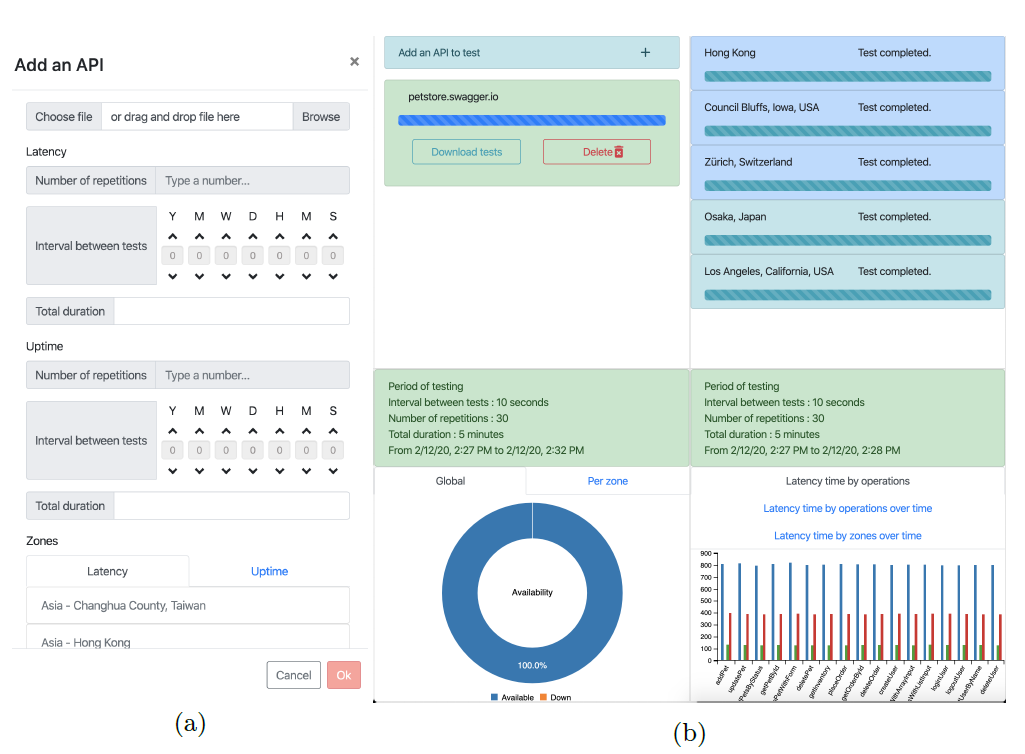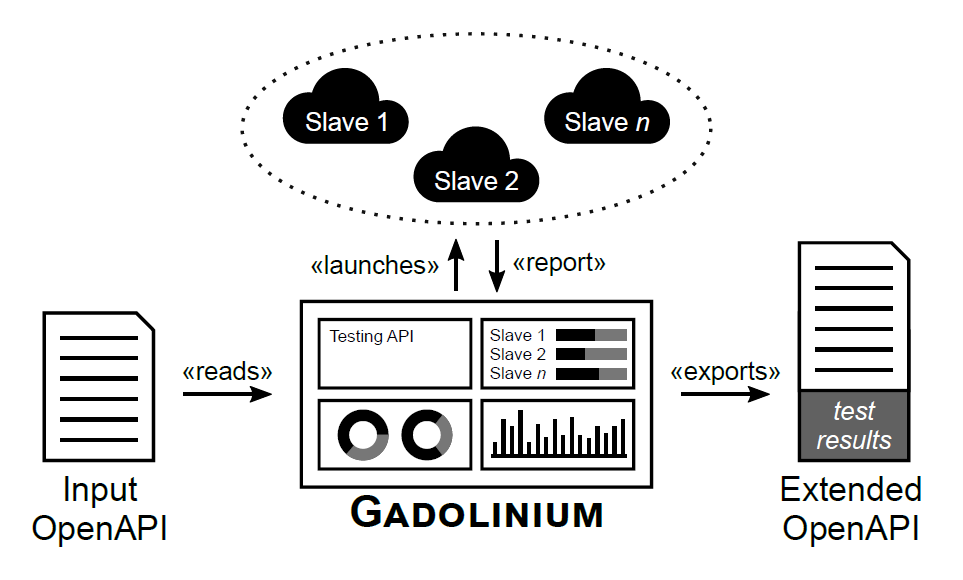Although OpenAPI describes efficiently RESTAPIs from a functional perspective, it does not outline the underlying non-functional properties out of such APIs. This important when having to choose among a set of APIs providing overlapping sets of data.
As our attempt to solve this challenge, we present Gadolinium, a testing framework to monitor the non-functional properties of REST APIs. Gadolinium uses the OpenAPI definition of the API (you can automatically discover such OpenAPI definition if needed). The result of these tests can eventually be downloaded and stored as part of the OpenAPI definition itself using our own extended version of the standard. Gadolinium will be presented at ICWE’20 (International Conference on Web Engineering).
In what follows we describe Gadolinium in more detail (download the paper pdf directly if you prefer). You can also view the recorded presentation:
1 Introduction
The Web has become the main source of information and services for both developers and big companies. Nowadays the most popular way to access this information is via REST APIs. REST APIs have been usually documented in natural language only, which hampers its understanding and use. In the last years, a number of specifications have appeared to formalize the definition of APIs and solve this problem. OpenAPI is now the de facto standard for this.
OpenAPI provides a specification language to describe the operations and data structures of REST APIs (don’t miss our OpenAPI chatbot to learn more about those). OpenAPI covers the functional and actionable elements of a REST API, however, OpenAPI does not provide any information regarding Non-Functional Properties (NFPs) like performance or availability, which are crucial to help developers choose and integrate the most suitable API for their applications.
In this paper we present Gadolinium, a framework that relies on OpenAPI to automatically test NFPs of REST APIs. The framework provides data schemas to describe NFPs and the required testing process, which relies on a master/slave architecture. The results of the test can eventually be stored in the OpenAPI description to enrich API information and make sure it is even more helpful for future developers evaluating its adoption. Our current implementation covers the test of performance and availability NFPs, and supports the deployment of clients in the Google Cloud platform.
To the best of our knowledge, ours is the first general approach to automatically test NFPs in OpenAPI. While some works have explored the definition of NFPs in Web development (e.g.,[2, 4, 3]) and others have studied how to benchmark quality aspects in Web APIs (e.g.,[1]), none of them mix the study and testing of NFPs in OpenAPI. Only some commercial tools (e.g., SOAP UI) propose NFP testing for REST APIs but mostly focusing on load testing.
2 Our Proposal
We propose a framework called Gadolinium that relies on the OpenAPI description of REST APIs to test NFPs of their operations.
Our proposal currently supports two NFPs: performance and availability. Others can be added following a similar approach to the one explained herein. Performance is measured by calculating the latency or time interval between a request and the response. Availability is measured via the API uptime (i.e., percentage of time the API is ready to receive requests). We use random values for mandatory parameters of the requests and omits values for optional ones.
Both properties should be evaluated considering that APIs can be transparently replicated in different locations and therefore users can access them from diverse geographical places. As such, NFPs values can change on a per geographical basis. To deal with this, Gadolinum follows a master/slave architecture where slaves are geographically distributed and deployed in different locations to ensure a good coverage of the test.
The image heading this post illustrates the overall architecture of our proposal. As can be seen, Gadolinium takes as input the OpenAPI description to be tested and monitored. Once the OpenAPI description is loaded, the user configures the testing process. At that point, the testing process launches several slaves to test the NFPs and report back the results. The master element of this architecture controls the slaves, monitors the sequence of events and displays a dashboard to the user summarizing the status of the testing process and its results. The user can then review and analyze the results, which can also be exported into the OpenAPI description provided initially using the standard extension mechanism of the OpenAPI specification.
Gadolinium is very easy to use as depicted in the following figure showing the import dialog, where the user provides the OpenAPI description and configures the process (part a) in the figure). The configuration involves (1) setting the number of times the API will be tested, (2) the time between tests and (3) the geographical zones to deploy the slaves for each NFP. Part b) in the figure shows an example of the results page. On top, it shows the importation and slaves execution data, including the progress until reaching the final stage. At the bottom, it shows the results of the uptime (on the left) as a pie chart and latency (on the right) as a bar chart that can be filtered according to either operations or geographical zones.

Example of dashboard in Gadolinium. (a) Adding an API and configuring the NFP metrics. (b) Results of the testing process.
3 Architecture
This section provides some more details on the architecture and implementation of Gadolinium. As we described above, the two key components are the master and the slaves. While the master can be deployed anywhere, slaves must be physically distributed and deployed in different locations of the world to ensure a good coverage for the NFPs tested. Next we describe the implementation of both master and slaves.
Master The Master is the central piece of Gadolinium and provides a dashboard to import OpenAPI files, monitor the APIs being tested and download results. The backend has been developed in NodeJS, providing an HTTP server for the frontend and a communication channel via SocketIO for slaves.
The frontend has been developed in Angular, allowing the user to provide an OpenAPI description and configure the testing process.
Slaves A slave is created to test a specific non-functional property of a REST API from a location. The lifecycle of a slave includes its deployment, configuration, connection to the Master to get the instructions (i.e., NFP and API to test), test execution and send back the results. Slaves have been developed as independent NodeJS applications running on Google’s data centers.
4 Conclusion
We have presented Gadolinium, a framework to test and monitor NFPs of REST APIs by leveraging the OpenAPI specification.
The approach currently supports testing and monitoring latency and uptime NFPs and provides a dashboard view to control the complete lifecycle of the testing process. Gadolinium has been made available on GitHub, where additional information about its inner workings can be found.
References
[1] Bermbach, D., Wittern, E.: Benchmarking Web API Quality. In: Int. Conf. in Web Engineering. pp. 188–206 (2016)
[2] Galster, M., Bucherer, E.: A Taxonomy for Identifying and Non-Functional Requirements in Service-Oriented Development. In: IEEE Congress on Services. pp. 345–352 (2008)
[3] Junghans, M., Agarwal, S.: Web Service Discovery Based on Unified View on Functional and Non-functional Properties. In: Int. Conf. on Semantic Computing. pp. 224–227 (2010)
[4] Ortiz, G., Núñez, J.H., Clemente, P.J.: How to Deal with Non-functional Properties in Web Service Development. In: Int. Conf. in Web Engineering. pp. 98–103 (2005)




Recent Comments